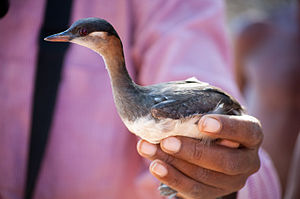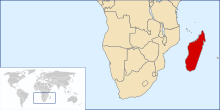Madagascar Little Grebe
| Madagascar Little Grebe | ||||||||||
|---|---|---|---|---|---|---|---|---|---|---|

Madagascar Little Grebe ( Tachybaptus pelzelnii ) |
||||||||||
| Systematics | ||||||||||
|
||||||||||
| Scientific name | ||||||||||
| Tachybaptus pelzelnii | ||||||||||
| ( Hartlaub , 1861) |
The Madagascar Little Grebe ( Tachybaptus pelzelnii ) is a monotypical species from the grebe family . The species occurs exclusively in Madagascar . The IUCN counts the Madagascar little grebe to the endangered ( vulnerable ) species. The total number of stocks is very low and is currently declining due to fish imported into Madagascar and intensified fishing. In addition, the habitat on which the Madagascar Little Grebe depends is being destroyed. The IUCN therefore assumes that the population decline will accelerate over the next ten years.
The Madagascar little grebe carries the epithon pelzelnii in honor of the Austrian ornithologist August von Pelzeln .
Appearance
The little grebe reaches a body length of 22 to 27 centimeters and weighs about 145 grams. The relatively slender beak is striking. The males are slightly larger than the females and tend to have the slightly longer beak.
In the magnificent dress , the top of the head is black up to the eyes. The throat is light gray. The ear spots are yellowish brown. The neck is gray, the chest is soot gray. The top and sides of the body are soot-brown and contrast with the large white spots that are located on the flanks. The hull is pale gray. The eyes are dark red. The beak is predominantly yellowish. However, during the breeding season it is black with a white tip. The feet are greenish. In the resting plumage, the plumage is a little more dull overall. The brownish yellow ear patches are then missing.
The voice is similar to that of the little diver , but the overall pitch is a bit darker.
Distribution area and habitat
The Madagascar Little Grebe only inhabits Madagascar and was widespread throughout the island in historical times and also settled at altitudes up to 2,000 meters above sea level. Meanwhile the Madagascar Little Grebe is missing in parts of its original range and is a rare species in the other areas. The highest population density is in the west and in the center of Madagascar, where couples and solitary Madagascar Little Grebes colonize the numerous small ponds and lakes. On Lake Alaotra , which used to be populated by hundreds of Madagascar little divers, the Delacour little grebe and, to a lesser extent, the common little grebe, there were only ten to twenty individuals in 1985. Lake Alaotra underwent a very strong change in the second half of the 20th century, which is also taking place to a lesser extent in other waters of Madagascar. The silting up of the banks and the discharge of manure into the lake led to dramatic changes in the microfauna. Exotic fish were introduced, for example tilapia , which ate the water lilies and thus robbed the birds of nesting material, and largemouth bass , which ate both the divers and their young. In the 1980s, predatory snakehead fish were also introduced to pursue the divers and their offspring.
The exact population of the Madagascar Little Grebe is not exactly known. The IUCN estimates the population at 1,500 to 2,000 individuals and expects the populations to continue to decline over the next ten years. Introduced fish, which on the one hand eat the chicks, but also reduce the availability of food resources for the Madagascar little grebe, contribute to the decline in the population. Wetlands, which give the Madagascar little grebe a retreat, are also increasingly being converted into rice fields.
The Madagascar little grebe prefers shallow lakes and ponds with a dense vegetation of water lilies. Occasionally it also occurs in brackish water and on slow flowing rivers.
behavior
The food spectrum of the Madagascar Little Grebe consists mainly of insects. It also eats fish and, to a lesser extent, crustaceans. It is often absent on ponds with larger fish. There you can find the common little grebe, which is also found in Europe. Madagascar little grebes are predominantly resident birds. However, they do go on hikes to find suitable habitats. The breeding season falls between August and March. Breeding pairs are usually territorial, but in waters that offer particularly suitable living conditions, the nests are also set up in close proximity to one another. Loose colonies of up to 150 individuals have already been observed. The nest is a floating platform made of aquatic plants, which is usually anchored to floating plants. It is often found near water lilies. The clutch size is three to four eggs.
supporting documents
Individual evidence
- ↑ a b BirdLife Factsheet , accessed July 11, 2009
- ^ Fjeldså, p. 158
- ^ Fjeldså, p. 159
literature
- Jon Fjeldså: The Grebes . Oxford University Press, 2004, ISBN 0-19-850064-5
Web links
- Tachybaptus pelzelnii inthe IUCN Red List of Threatened Species 2012.2. Listed by: BirdLife International, 2012. Retrieved June 18, 2013.
